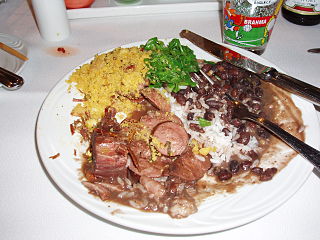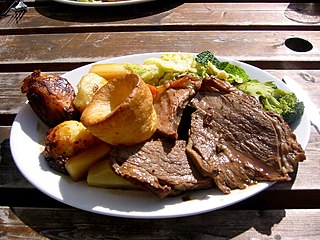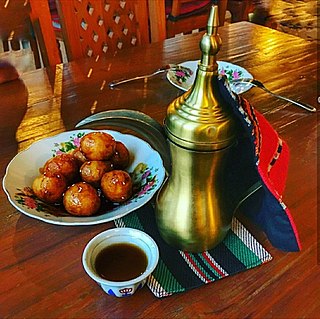
Vegetarian cuisine is based on food that meets vegetarian standards by not including meat and animal tissue products. For lacto-ovo vegetarianism, eggs and dairy products, such as milk and cheese, are permitted. For lacto vegetarianism, the earliest known type of vegetarianism, dairy products, such as milk and cheese, are permitted. The strictest forms of vegetarianism are veganism and fruitarianism, which exclude all animal products, including dairy, honey, and some refined sugars if filtered and whitened with bone char. There are also partial vegetarians who do not eat meat but may eat fish.

Pakistani cuisine can be characterized by a blend of various regional cooking traditions of the Indian subcontinent, Central Asia as well as elements from its Mughal legacy. The various cuisines are derived from Pakistan's ethnic and cultural diversity.

Bengali cuisine is a culinary style originating in Bengal, a region in the eastern part of the Indian subcontinent, which is now divided between Bangladesh and the Indian states of West Bengal, Tripura and Assam's Barak Valley. With an emphasis on fish, vegetables and lentils are served with rice as a staple diet.

Latin American cuisine is the typical foods, beverages, and cooking styles common to many of the countries and cultures in Latin America. Latin America is a highly diverse area of land that holds various cuisines that vary from nation to nation. Some items typical of Latin American cuisine include maize-based dishes arepas, pupusas, tacos, tamales, tortillas and various salsas and other condiments. These spices are generally what give the Latin American cuisines a distinct flavor; yet, each country of Latin America tends to use a different spice and those that share spices tend to use them at different quantities. Thus, this leads for a variety across the land. Sofrito, a culinary term that originally referred to a specific combination of sautéed or braised aromatics, exists in Latin American cuisine. It refers to a sauce of tomatoes, roasted bell peppers, garlic, onions and herbs.

Pilaf, or pilau is a rice dish or, in some regions, a wheat dish, whose recipe usually involves cooking in stock, adding spices, and other ingredients such as meat, and employing some technique for achieving cooked grains that do not adhere.
Traditionally, the various cuisines of Africa use a combination of locally available fruits, cereal grains and vegetables, as well as milk and meat products, and do not usually have food imported. In some parts of the continent, the traditional diet features an abundance of milk, curd and whey products.

Arab cuisine is the cuisine of the Arabs, defined as the various regional cuisines spanning the Arab world, from the Maghreb to the Fertile Crescent and the Arabian Peninsula. The cuisines are often centuries old and reflect the culture of great trading in spices, herbs, and foods. The three main regions, also known as the Maghreb, the Fertile Crescent, and the Arabian Peninsula have many similarities, but also many unique traditions. These kitchens have been influenced by the climate, cultivating possibilities, as well as trading possibilities. The kitchens of the Maghreb and Levant are relatively young kitchens that were developed over the past centuries. The kitchen from the Khaleej region is a very old kitchen. The kitchens can be divided into the urban and rural kitchens.

Iraqi cuisine or Mesopotamian cuisine has a long history going back some 10,000 years – to the Sumerians, Akkadians, Babylonians, Assyrians, and ancient Persians. Tablets found in ancient ruins in Iraq show recipes prepared in the temples during religious festivals – the first cookbooks in the world. Ancient Iraq, or Mesopotamia, was home to a sophisticated and highly advanced civilization, in all fields of knowledge, including the culinary arts. However, it was in the Islamic Golden Age when Baghdad was the capital of the Abbasid Caliphate (750–1258) that the Iraqi kitchen reached its zenith. Today, the cuisine of Iraq reflects this rich inheritance as well as strong influences from the culinary traditions of neighbouring Iran, Turkey and the Syria region area.

Cuisine of the Indian subcontinent includes the cuisines from the Indian subcontinent comprising the traditional cuisines from Bangladesh, Bhutan, India, Nepal, Pakistan, Sri Lanka and the Maldives.

British cuisine is the heritage of cooking traditions and practices associated with the United Kingdom. Although Britain has a rich indigenous culinary tradition its colonial history has profoundly enriched its native cooking traditions. British cuisine absorbed the cultural influences of its post-colonial territories – in particular those of South Asia.

Afghan cuisine is largely based upon the nation's chief crops, such as wheat, maize, barley and rice. Accompanying these staples are native fruits and vegetables as well as dairy products such as milk, yogurt Doogh and whey. Kabuli Palaw is the national dish of Afghanistan. The nation's culinary specialties reflect its ethnic and geographic diversity. Afghanistan is known for its high quality pomegranates, grapes, and sweet, Rugby-football shaped melons.

Mughlai cuisine consists of dishes developed in Medieval India at the centres of the Mughal Empire. It represents a combination of South Asian cuisine with the cooking styles and recipes of Central Asian cuisine. Mughlai cuisine is strongly influenced by the cuisine of Central Asia, the region where the early Turko-Mongol Mughal emperors originally hailed from, and it has in turn strongly influenced the regional cuisines of modern Northern India, Pakistan and Bangladesh.

There is a rich and ancient culture in Eastern Arabia. Eastern Arabia's culture has always been oriented towards the sea. While being Arab at its core, it has been heavily influenced by the cultures of Persia, South Asia and Horn of Africa, because of extensive trade links.

Middle Eastern cuisine is the cuisine of the various countries and peoples of the Middle East. The cuisine of the region is diverse while having a degree of homogeneity. It includes Arab, Iranian/Persian, Israeli/Jewish, Assyrian, Kurdish, Cypriot, and Turkish cuisines. In 2017, Middle Eastern cuisine was claimed by many sources to be one of the most popular and fastest growing ethnic cuisines in the US. Some commonly used ingredients include olives and olive oil, pitas, honey, sesame seeds, dates, sumac, chickpeas, mint, rice, and parsley. Some popular dishes include kebabs, dolma, falafel, baklava, yogurt, doner kebab, shawarma and Mulukhiyah.






























